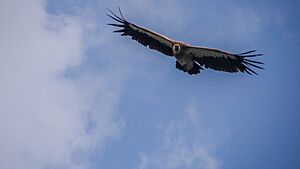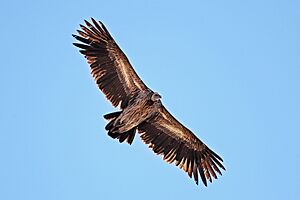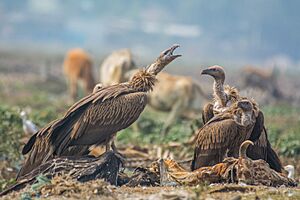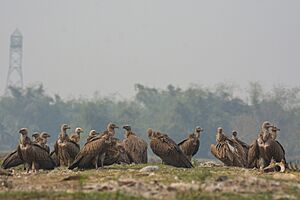Himalayan vulture facts for kids
Quick facts for kids Himalayan vulture |
|
|---|---|
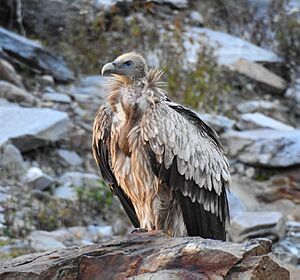 |
|
| Conservation status | |
| Scientific classification | |
| Genus: |
Gyps
|
| Species: |
himalayensis
|
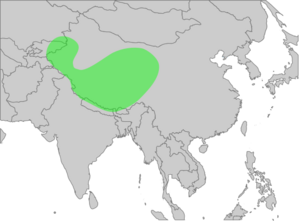 |
|
The Himalayan vulture (Gyps himalayensis), also called the Himalayan griffon vulture, is a large bird found in the Himalayas and the nearby Tibetan Plateau. It's a type of Old World vulture, which means it lives in Europe, Asia, and Africa. This amazing bird is one of the biggest true raptors, or birds of prey, in the world.
Sadly, the Himalayan vulture is listed as Near Threatened on the IUCN Red List. This means its population could be at risk in the future. It's important not to confuse it with the Eurasian griffon vulture (Gyps fulvus), which looks similar and lives in some of the same areas.
Contents
What Does the Himalayan Vulture Look Like?
| Measurements | |||
|---|---|---|---|
| Length | 1,030–1,150 mm (41–45 in) | ||
| Culmen | 71–77 mm (2.8–3.0 in) | ||
| Wing | 755–805 mm (30–32 in) | ||
| Tail | 355–405 mm (14–16 in) | ||
| Tarsus | 110–126 mm (4.3–5.0 in) | ||
Himalayan vultures have dark brown feathers on their wings and tail. Their upper body is a pale, sandy color. Their legs are covered in light, buff-colored feathers. Young vultures have white downy feathers on their heads. As they grow up, this down turns yellowish. Adult vultures also have a long, pale brown "ruff" of feathers around their neck.
Their face has pale blue skin, and their beak is yellowish. When they fly, you can see their long "fingers" (the ends of their wing feathers) spread out. They also have a light stripe under their wings. The dark wing and tail feathers stand out against their lighter body. This helps tell them apart from the slightly smaller griffon vulture.
These vultures are the largest of their kind, the Gyps species. They are often considered the largest and heaviest birds in the Himalayas. They can weigh anywhere from 6 to 12.5 kilograms (about 13 to 27 pounds). Their wingspan, how wide they are with their wings spread, can be from 2.56 to 3.1 meters (about 8.4 to 10.2 feet).
Where Do Himalayan Vultures Live?
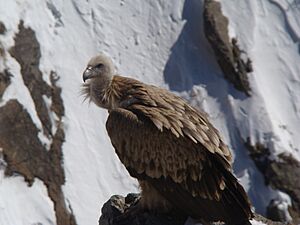
The Himalayan vulture mostly lives in the high mountains of the Himalayas. They also live on the Tibetan Plateau. You can find them at very high elevations, from about 1,200 to 5,500 meters (about 3,900 to 18,000 feet) above sea level.
Their home range stretches across many countries. These include Kazakhstan, Uzbekistan, Kyrgyzstan, Tajikistan, Afghanistan, and Iran. They also live in Pakistan, India, Nepal, Bhutan, western China, and Mongolia. Young vultures sometimes travel further south. They have even been seen as far away as Thailand, Burma, Singapore, and Cambodia.
How Do Himalayan Vultures Behave?
Diet and Feeding Habits
Himalayan vultures often rest on rocky cliffs. They usually stay at elevations above 1,215 meters (about 4,000 feet). These vultures love to sunbathe on rocks. They soar high in the sky using warm air currents called thermals. They are not very good at flying by flapping their wings for long periods.
Groups of vultures might follow grazing animals up the mountains. They do this to find dead animals to eat. When a vulture lands on a dead animal, it might make a rattling sound. They can also grunt or hiss when resting or eating. While feeding, they sometimes make cackling sounds to protect their food from other vultures.
Himalayan vultures are social birds. They are often found in large groups. Sometimes, crows join them, but the vultures are much bigger and stronger. These vultures eat only dead animals, also known as carrion. They will even eat meat that has started to rot. On the Tibetan Plateau, most of their food comes from dead yaks. They often wait a few days near a dead animal before eating it. They usually eat the fleshy parts and avoid the organs, which other vultures might eat.
These vultures are quite dominant around other scavengers. They usually get the best parts of a carcass. However, they will give way to gray wolves, snow leopards, and cinereous vultures. A large group of these vultures can strip a human or sheep carcass of all its meat in just 30 minutes! They can do the same to a yak carcass in about two hours. Interestingly, Himalayan vultures have been seen eating pine needles, but scientists don't know why.
Reproduction and Life Cycle
The breeding season for Himalayan vultures starts in January. They build their nests on hard-to-reach ledges on cliffs. The nest is made of sticks. In northeastern India, nests have been found between 1,215 and 1,820 meters (about 4,000 to 6,000 feet) high. In Tibet, nests can be as high as 4,245 meters (about 13,900 feet).
Several pairs of vultures might nest on the same cliff. A typical group, or colony, has about five to seven pairs. Their nests are quite small for such large birds. Even though they get bigger with repeated use, they don't become as huge as the nests of some other large birds of prey. Sometimes, a Himalayan vulture might even use a nest built by a bearded vulture.
The female vulture usually lays a single white egg. The egg often has red spots. In northern India, eggs are laid between December 25 and March 7. The egg is rough and oval-shaped. It can be about 87 to 103.6 mm long and 65 to 74 mm wide. In zoos, the egg takes about 54 to 58 days to hatch. Young vultures stay with their parents for six to seven months after hatching.
What Threats Do Himalayan Vultures Face?
Himalayan vultures can get sick from a medicine called diclofenac. This drug was used in farm animals. When these animals died, and their bodies were eaten by vultures, the drug harmed the birds. This caused a fast decline in other Gyps vulture populations across Asia.
However, Himalayan griffon vulture numbers have not dropped as quickly as some other vulture species. Still, fewer nesting birds have been seen in some parts of their range in Nepal. This shows that they still face challenges.



